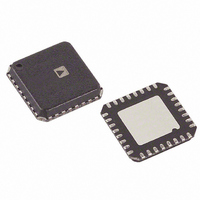ADAU1361BCPZ Analog Devices Inc, ADAU1361BCPZ Datasheet - Page 33

ADAU1361BCPZ
Manufacturer Part Number
ADAU1361BCPZ
Description
IC CODEC 24B PLL 32LFCSP
Manufacturer
Analog Devices Inc
Type
Audio Codecr
Datasheet
1.ADAU1361BCPZ-RL.pdf
(80 pages)
Specifications of ADAU1361BCPZ
Data Interface
Serial
Resolution (bits)
24 b
Number Of Adcs / Dacs
2 / 2
Sigma Delta
No
Voltage - Supply, Analog
1.8 V ~ 3.6 V
Voltage - Supply, Digital
1.8 V ~ 3.6 V
Operating Temperature
-40°C ~ 85°C
Mounting Type
Surface Mount
Package / Case
32-VFQFN, CSP Exposed Pad
Audio Codec Type
Stereo
No. Of Adcs
2
No. Of Dacs
2
No. Of Input Channels
6
No. Of Output Channels
7
Adc / Dac Resolution
24bit
Adcs / Dacs Signal To Noise Ratio
101dB
Lead Free Status / RoHS Status
Lead free / RoHS Compliant
Available stocks
Company
Part Number
Manufacturer
Quantity
Price
Company:
Part Number:
ADAU1361BCPZ
Manufacturer:
TOSHIBA
Quantity:
1 650
Company:
Part Number:
ADAU1361BCPZ
Manufacturer:
ADI
Quantity:
624
Part Number:
ADAU1361BCPZ
Manufacturer:
ADI/亚德诺
Quantity:
20 000
Part Number:
ADAU1361BCPZ-R7
Manufacturer:
ADI/亚德诺
Quantity:
20 000
OUTPUT
NOISE GATE FUNCTION
When using the ALC, one potential problem is that for small
input signals, the PGA gain can become very large. A side effect
of this is that the noise is amplified along with the signal of
interest. To avoid this situation, the ADAU1361 noise gate can
be used. The noise gate cuts off the ADC output when its signal
level is below a set threshold. The noise gate is controlled using
the following parameters in the ALC Control 3 register
(Address 0x4014):
•
•
•
One common problem with noise gate functions is chatter,
where a small signal that is close to the noise gate threshold
varies in amplitude, causing the noise gate function to open and
close rapidly. This causes an unpleasant sound.
To reduce this effect, the noise gate in the ADAU1361 uses a
combination of a timeout period and hysteresis. The timeout
period is set to 250 ms, so the signal must consistently be below
INPUT
TARGET
GAIN
NGTYP[1:0]: The noise gate type is set to one of four
modes by writing to the NGTYP[1:0] bits.
NGEN: The noise gate function is enabled by writing to the
NGEN bit.
NGTHR[4:0]: The threshold for muting the output is set by
writing to the NGTHR[4:0] bits.
Figure 38. Effect of Varying the Maximum Gain Parameter
MAX GAIN = 30dB
Figure 37. Basic ALC Operation
HOLD
TIME
MAX GAIN = 24dB
DECAY
TIME
INPUT LEVEL (dB)
MAX GAIN = 18dB
ATTACK
TIME
GAIN POINT
MIN PGA
Rev. C | Page 33 of 80
the threshold for 250 ms before the noise gate operates.
Hysteresis is used so that the threshold for coming out of the
mute state is 6 dB higher than the threshold for going into the
mute state. There are four operating modes for the noise gate.
Noise Gate Mode 0 (see Figure 39) is selected by setting the
NGTYP[1:0] bits to 00. In this mode, the current state of the
PGA gain is held at its current state when the noise gate logic is
activated. This prevents a large increase in background noise
during periods of silence. When using this mode, it is advisable
to use a relatively slow decay time. This is because the noise gate
takes at least 250 ms to activate, and if the PGA gain has already
increased to a large value during this time, the value at which
the gain is held will be large.
ENABLE SIGNAL
Noise Gate Mode 1 (see Figure 40) is selected by setting the
NGTYP[1:0] bits to 01. In this mode, the ADAU1361 does a
simple digital mute of the ADC output. Although this mode
completely eliminates any background noise, the effect of an
abrupt mute may not be pleasant to the ear.
ENABLE SIGNAL
NOISE GATE
NOISE GATE
INTERNAL
INTERNAL
ANALOG
ANALOG
OUTPUT
DIGITAL
OUTPUT
DIGITAL
INPUT
INPUT
MUTE
MUTE
GAIN
GAIN
Figure 39. Noise Gate Mode 0 (PGA Gain Hold)
Figure 40. Noise Gate Mode 1 (Digital Mute)
250ms
250ms
THRESHOLD
THRESHOLD
GAIN HELD
ADAU1361













